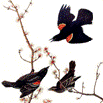Center, Internet, Wildlife Damage Management

Bird Control Seminars Proceedings
Document Type
Article
Date of this Version
11-1-1979
Abstract
Red-winged blackbird (Agelaius phoeniceus) dispersal patterns from a communal roost and associated habitat relationships were studied in central New York State during summer and fall, 1976 and 1977. Density of foraging birds in a 10° sector out to 48 km from a roost was highest at 10 km. The greatest density of after-hatching-year (AHY) males occurred at approximately 10 km; of hatching-year (HY) birds, males and females, at approximately 18 km. HY females generally foraged further than did HY males, as well as further than AHY males. Relative proportions of each habitat type and arrangement pattern of habitats were mapped in the 10° sector. Corn covered 36% of the total area mapped, nearly twice as much as the next most abundant category, hay, which covered 19%. When dispersed from the roost, redwings used cornfields far more than any other habitat type. Data suggest that for the premigration period (before September 30) redwing habitat use averag- ed 77% in cornfields. During migration (after September 30) habitat use averaged 47% in cornfields and 48% in trees. Overall corn arrangement pattern did not correlate with overall redwing dispersal patterns. However, on a local level at various distances from a roost, redwings foraged primarily in cornfields.

